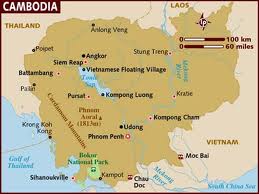 I’m still thinking about Cambodia. When there, when I wasn’t reading faces, or reading between the lines of the socio-economic polka of carefree tourists and often profoundly poor locals, or skimming for the wisdom in ancient piles of stone such as Angkor Wat, I read Carol Livingston’s 1997 memoir of Cambodia. Gecko Tails sounds like a children’s book; at first I thought it must be Livingston making punning reference to the stories she heard in a Phnom Penh ex-pat bar, the Gecko. But this benign little lizard, climbing walls wherever one travels in southeast Asia, has the ability to grow a new tail after sacrificing the old one to predators. This must be symbolic of Livingston’s hope for the country. (It’s still a weak title.) The book recounts her earlier tours of love and duty, and it’s pretty average¹, though the subject is strikingly unaverage: the latter days of the bitter Cambodian civil war. It’s nearly 20 years old now, but I still found it useful in fleshing out my dim and youthful impressions of killing fields and other by-products of the bloody Vietnam War. As an introduction to Cambodia that goes beyond beaches, cheap travel and temple tourism, it works well.
I’m still thinking about Cambodia. When there, when I wasn’t reading faces, or reading between the lines of the socio-economic polka of carefree tourists and often profoundly poor locals, or skimming for the wisdom in ancient piles of stone such as Angkor Wat, I read Carol Livingston’s 1997 memoir of Cambodia. Gecko Tails sounds like a children’s book; at first I thought it must be Livingston making punning reference to the stories she heard in a Phnom Penh ex-pat bar, the Gecko. But this benign little lizard, climbing walls wherever one travels in southeast Asia, has the ability to grow a new tail after sacrificing the old one to predators. This must be symbolic of Livingston’s hope for the country. (It’s still a weak title.) The book recounts her earlier tours of love and duty, and it’s pretty average¹, though the subject is strikingly unaverage: the latter days of the bitter Cambodian civil war. It’s nearly 20 years old now, but I still found it useful in fleshing out my dim and youthful impressions of killing fields and other by-products of the bloody Vietnam War. As an introduction to Cambodia that goes beyond beaches, cheap travel and temple tourism, it works well.
¹ An “average” book, I guess, until I check the official AuthorPub BookReport™, which reads: Livingston 1, Howden 0. Scoreboard, baby! Not to mention that it did receive quite a nice mention in the New York Times. However, I didn’t find any other mention of her and her work on-line; I wonder where she is.
Gecko Tails is competently written, though no masterpiece. For me it got stronger as it went along. It seems that the young Ms. Livingston, to a significant degree, came of age during the two twenty-something years she spent in Cambodia. It was the mid-1990s. The Khmer Rouge and its crazed, genocidal regime had been ousted by the late ‘70s, but they continued to wage civil war for the twenty years that followed. Livingston was there for the beginning of the end of that brutal period. The book is wryly funny at the beginning, cracking sarcastic on the ex-patriate life through the eyes of two somewhat jaded young Western women – the author and her travel buddy – but as she grows in understanding, so does the book become ever more somber, introspective and compassionate. She clearly came to love the ethnic Khmer people, the majority of Cambodians.
Early sketches of The Professional Traveller (world-weary, superior, he’s seen everything before you have), The Shouter (a Cambodian “English teacher” with dreadful language skills but loud conviction and a marketing plan), Fester the Molester (you get the idea) and Laurie the Spook (an attractive American who seems to know everything – and it turns out she does) ease us into the strangeness of life in Cambodia, with stories of ‘innocents abroad’ mixed with snide observations about political machinations, and plenty of boozy nights and reveries fuelled by cheap southeast Asian marijuana. It’s arch, rather gossipy at the start, but also careful to protect identities, especially for vulnerable locals but for the foreigners, too. These are old Asia hands, young adventure-seekers, misfits, profiteers, military observers, and those working with the United Nations Transitional Authority in Cambodia (UNTAC) in preparation for the 1998 elections. “Somewhere, sometime, in God knows whose company, I fell, if not in love, at least in fascination with the place,” writes Livingston.
She wanted to be a journalist, and the longer she was there, the more sympathetic she grew toward the beleaguered nation’s people, and the less clear became the lines between good guys and bad. For the Khmer Rouge leadership – and particularly the maniacal “Pol Pot”, whom she refuses to call by this well-known pseudonym in preference for his given name, Saloth Sar – her antipathy is unreserved, and she recounts their insane attempts at social engineering, societal upheavals that make the excesses of the Chinese Cultural Revolution look moderate by comparison. Yet, at the local level, she can see how the Khmer Rouge sometimes created strong communities, and how corrupted were the efforts of those who opposed and vilified them. The competitiveness and the inevitably partial treatment that standard war journalism necessitated were discouraging to Livingston.
Out of money, she left and was able to sell her book idea in London, enabling her return. Her friend Amanda’s apartment had, in the meantime, been overrun by the relatives of the Cambodian fiancée of “Mister Edgar”, a French NGO employee. Ming, the reluctant daughter engaged to be married through the pragmatic scheming of her mother, is the first of several feeling portraits of the women of Cambodia. This is where the book begins to shine, though with a harsh and sobering light. She describes the Ming she encountered in private, a lively girl full of wit and intelligence – until Edgar and the wedding preparations come near. By then, “Ming had fled, and a small quiet Cambodian doll had taken her place.” She ends up in France with money to spend, though, unlike Mi, a former prostitute who becomes the live-in girlfriend of an English military operative. When scrutiny of this casual arrangement grows, suddenly the grizzled Brit is reassigned and leaves $200 behind as his only good-bye. Livingston later tries to find her – is she selling oranges? her aging body? – but with no luck.
Livingston finds that “maybe I can’t live anywhere else”, the conservative life of comfortable suburban acquisition feeling pale next to the turbulence, pain and surprising graces of every and any Cambodian day. She leaves. She returns, after a constitutional rearrangement has restored the eminently flexible Prince Sihanouk to a renewed monarchy, with two Prime Ministers from different political factions — one of whom is his son — sharing the power. She follows as UNTAC reduces its presence, and civil war continues with the Khmer Rouge in the hills and along the Thai border. “Things don’t always work out the way you plan, do they?” Laurie the Spook had said early in Livingston’s sojourn. She learns how hardly won was the painful wisdom of this one-time American intelligence agent, but by book’s end, Livingston herself is the veteran: blithely ignoring nearby gunshots while her newbie roommate cowers on the floor.
As Livingston concludes her memoir, the 1998 elections were approaching, which furthered a nearly unimaginable process whereby the Khmer Rouge have been reintegrated into Cambodian society. Very few were prosecuted for war crimes; many were given amnesty; Saloth Sar died before he could be brought to trial. Livingston tries to finish on an upbeat note, and has limited success. She predicts: “Skirmishes of guerrilla war will go on for awhile. The good guys and the bad guys will not be so easily defined….Anyone who confidently assures you they really know what’s happening in Cambodia, and why, is probably wrong….Angkor [Wat] will remain, and the hard work and hopefully Cambodians’ good humour. They will continue to rebuild their country, but the bad will take some time to go. It’s Cambodia.”
Reading this book on a fairly comfortable tourist’s path, and finishing it amid the peace and never-ending sunshine of southern Thailand, made it all the more fascinating. There are lots of Cambodian men with missing limbs from the landmines, which still take the occasional life in the countryside. The population is stunningly young, and among those older than 40, the proportion of men is visibly small. It’s not hard to find poverty, especially once you get away from the starry tourist havens near Angkor Wat and the other astounding remains of the Khmer Empire. Yet the tentative, grimly hopeful tone of Livingston’s conclusion to Gecko Tails – and perhaps it shouldn’t be so surprising, but it got me – in 2014 sounds pretty accurate, maybe even a little too subdued. What can people recover from? If my eyes are any gauge, Cambodia proves that human beings can endure and recover from absolutely anything.


